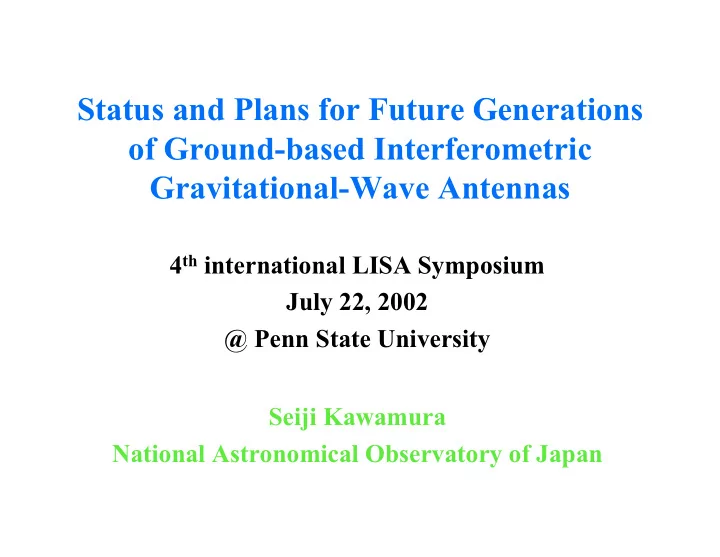

Status and Plans for Future Generations of Ground-based Interferometric Gravitational-Wave Antennas 4 th international LISA Symposium July 22, 2002 @ Penn State University Seiji Kawamura National Astronomical Observatory of Japan
Contents 1. Current Detectors to Future Generations 2. Advanced Technology (Seismic Noise and Thermal Noise) 1. Status and Future Plan 2. Conclusions
EURO Interferometric Upgrade GW Detector VIRGO GEO LIGO Advanced LIGO LCGT LIGO AIGO TAMA
Evolution of Interferometric GW Detectors 3 rd Generation 5 th Generation Current Generation Seismic Noise Radiation Strain Strain Strain Shot Noise Pressure Noise Radiation Thermal Noise Beyond SQL Pressure Noise Shot Noise Frequency Frequency Frequency 2 nd Generation 4 th Generation Seismic Noise Standard Strain Strain Quantum Limit Thermal Noise Shot Noise Frequency Frequency
Significance of Seismic Isolation Ground Ground Improve control Large Motion noise, lock Displacement acquisition, and Isolation Improve lock stability System seismic noise Mirror directly 0.1 1 10 100 Mirror Frequency [Hz] Small Motion
Examples of Control Noise Control System Loop Gain 1 Control More noise attenuation imposed Frequency Control Force (Length/Alignment) Mirror
More Isolation Ground Lower resonant frequencies More stages Potential Energy Original Isolation System Resultant Displacement Anti-spring Mirror
Super-attenuator Inverted (VIRGO) pendulum Magnetic anti-spring
Performance of Super-attenuator � Recycled short-Michelson locked � 10 -11 m/Hz 1/2 at 2Hz
SAS (LIGO-TAMA Collaboration) � 3m FP cavity locked (Takamori et al.) � To be installed in TAMA in 2004 Geometrical anti-spring (DeSalvo et al.)
Multiple Pendulum � Triple Pendulum used for GEO � Quadruple pendulum developed for LIGO2
Underground Site Kamioka 220km Tokyo (NAOJ)
LISM (20m Prototype in Kamioka) and TAMA300 TAMA300 LISM (Sato) Maximum 24 hours 170 hours Continuous (summer (Spring 2001) Locking 2001) Duty Cycle 86% (for the 99.8% (for the 2001 summer last week of 2001 run) summer run)
Thermal-related Noise Solutions: Pendulum thermal noise � Low Thermal expansion Thermoelastic noise by Internal mode thermal noise Thermodinamic fluctuations (Braginsky, et al.) Solutions: � Low-loss material � Low-loss fabrication Thermoelastic noise by � Cryogenic temperature Photothermal fluctuations (Braginsky, et al.)
Monolithic Suspension Low pendulum thermal noise • Weld and Silicate bonding used for GEO - Low loss in fiber itself - Low loss at the release point
Sapphire at Cryogenic Temperature • kT-energy: low • Quality factor: high (Uchiyama, et al.) • Thermo-elastic noise: low (Cerdonio, et al.) - Thermal expansion rate: low • Thermal lensing: negligible (Tomaru, et al.) - Thermal conductivity: high (20k-30k) - dn/dT: small
Issues on Cryogenic Technologies • Seismic Isolation compatible with cryogenic • Contamination of mirrors (Miyoki, et al.) • Required cooling time • Heat link • Reduction of power dissipation - Improve absorption loss - Resonant sideband extraction
Resonant Sideband Extraction Lower power at BS and front mirrors ⇒ Less heat produced RSE PRFPMI High power Low power High finesse Low finesse recycling gain recycling gain cavity cavity Signal Extraction Detuning possible Mirror by shifting SEM
Features of Advanced LIGO • Reasonable and significant improvement from Initial LIGO on all the aspects • A large number of scientists working on R&D • Collaboration with GEO, VIRGO, ACIGA, TAMA • Most matured among all the advanced detectors
Design of Advanced LIGO
Current Status and Plan of LIGO • Intensive R&D going on • Construction funding proposal late 2002 • Could be funded by early 2005 • Installation of new detectors starting in as early as 2006
Features of LCGT • Cryogenic • To be located in the Kamioka mine • Arm length: 3km • SAS (DeSalvo) • RSE (Mizuno) • Suspension-point interferometer (Drever)?
Suspension Point Interferometer • Reduce vibration caused by the heat link; verified by experiment (Aso, et al.) • Possibility of implementing low-frequency (lower cavity) and high-frequency (higher cavity) interferometers (Aso)
Aimed Sensitivity of LCGT
Current Status and Plan of LCGT • Four-year budget approved for R&D (and observation and modification of TAMA) • Various R&Ds going on • Design efforts going on • Aiming at obtaining the budget in 2005
Test of Technologies for LCGT • SAS – @ TAMA (with LIGO) • RSE – @ 40m, Caltech (with LIGO and GEO) • High Power Laser - @ TAMA? (with ACIGA) • Cryogenic technology – @ CLIO
CLIO - Prototype for LCGT 100m Cryogenic prototype in Kamioka mine - Construction to be started very soon
AIGO • Currently 80m testbed for high power (Collaboration with LIGO) and for advanced suspension with Euler spring and Nb flexures • Eventually extended to a km-class advanced detector
Upgrade of GEO • All reflected configuration with Silicon optics (Low-loss diffractive structure, low mechanical loss: to be investigated very soon) • Initially cooled to 120k? (No thermo-elastic noise because of zero expansion coefficient) • high-power YAG lasers (200 W) • Non-classical light sources • Upgrade takes place in 2006-9
EURO (European Future Detector) • Conceptual design being/will be discussed including the following possibilities: - Cryogenic at 4K? - Underground? - SQL limited sensitivity for 1 ton Silicon? • Input from the results of the current- generation and the 2 nd generation of detectors • Starting not before 2008?
DECIGO (Deci-hertz Interferometer Gravitational Wave Observatory) • Candidate for Japanese space antenna project with shorter arm length • One of the scientific objectives: measure the acceleration of the expansion of the Universe (Seto, et al. PRL) • DECIGO-WG convened in 2002; currently 80 members Expansion ĸ 10 -18 DECIGO Acceleration? NS-NS (z ĝ 1) GW LISA Output Strain [Hz - 10 -20 Template (No Acceleration) Terrestrial Strain Detectors DECIGO 1/2 ] 10 -22 (Sensitivity: Phase Delay ĝ Real Signal ? Arbitrary) 10 -24 Time 10 -4 10 -2 10 0 10 2 10 4 1sec (10 years) Frequency [Hz]
Conclusions • Various levels of advanced detectors being developed/studied/considered • Various kinds of new technologies to reduce noise already developed/being/will be developed • Various levels of international collaboration going on to aim at international detector network • These efforts will bring us to the establishment of GW astronomy in the future
Recommend
More recommend